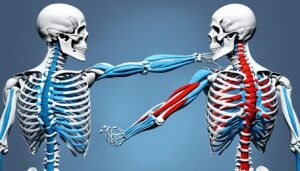Are you feeling lower back pain when walking or standing a lot? You’re not the only one. This issue has many causes, from tired muscles to problems with your spine. It’s important to know what’s causing your pain to find the right treatment.
Muscle soreness is a main reason for back discomfort during walking. Too much walking with back pain can wear out the lower back and leg muscles. So, you might feel better when you take a break by sitting or lying down. Being overweight can make this kind of pain worse.
Other things like spinal stenosis, degenerative disc disease, hyperlordosis, and sciatica can also cause lumbago on foot. Telling what’s causing your pain needs looking at your symptoms and health history.
Key Takeaways
- Lower back pain when walking or standing can have various causes, including muscle fatigue, spinal conditions, and postural issues.
- Prolonged walking or standing can tire out the muscles in the lower back and legs, leading to aches and pains.
- Overweight individuals may be more susceptible to muscle fatigue and lower back pain when walking or standing.
- Treatment options can include rest, hot or cold therapy, over-the-counter pain relievers, and gentle exercises to stretch and strengthen the muscles.
- Maintaining a healthy weight and practicing good posture can help prevent lower back pain when walking or standing.
Muscle Fatigue as a Cause
Muscle fatigue makes your lower back hurt when you stand or walk. Standing or walking for a long time makes your muscles tired. This happens in your lower back and legs. It causes aches and pains. But, resting by sitting or lying down often helps. If you’re overweight, you might feel this more when you’re on your feet.
Rest and Recovery Strategies
To feel better from muscle fatigue, you can try a few things. Resting is key. You can also use hot or cold packs and take over-the-counter pain meds. Gentle stretching and loosening up tight muscles can help, too. Being at a moderate weight lessens stress on your back and legs.
Strengthening Core Muscles
Building up your core muscles can stop the pain from coming back. Doing regular exercises for your core is good. It helps your spine and lowers the strain on your lower back. This is especially helpful when you stand or walk a lot.
Spinal Stenosis and Lower Back Pain
Spinal stenosis can cause lower back pain when you move around. It’s when the spine gets narrow, putting more pressure on the spinal cord and nerves. This leads to lower back pain. People with this issue might feel better when they sit or lean forward.
Symptoms of Lumbar Spinal Stenosis
Lumbar spinal stenosis can also make your legs weak. You might feel tingling in your back, butt, or legs. Sharp leg pain, known as sciatica, is another sign. In bad cases, you might have trouble controlling your bowel or bladder, and your sex life may be affected.
Treatment Options for Spinal Stenosis
Many ways can help with spinal stenosis and the pain. This includes physical therapy, pain relievers, and shots to reduce swelling. For worse cases, surgery might be needed to fix the spine. Acupuncture and chiropractic care could also help some people.
Staying at a healthy weight, exercising, and not smoking can prevent spinal stenosis. By talking with your doctor, you can make a plan to handle your pain and get back to enjoying life.
Degenerative Disc Disease and Walking
As we get older, the discs between our backbones can wear down. This is called degenerative disc disease. It can make the bones in our spine rub together, leading to lower back pain and stiffness. Walking can often help these symptoms, but they might get worse when standing or doing certain movements.
If you have degenerative disc disease, you might also feel pain in your buttocks and thighs. Sometimes, your legs or feet can feel weak. It’s important to keep a good posture and avoid activities that make the pain worse.
Conservative Treatment Methods
Thankfully, there are gentle ways to help with degenerative disc disease. This can include taking nonsteroidal anti-inflammatory drugs (NSAIDs). Using ice or heat packs on the area can also help. Plus, physical therapy can make your muscles stronger and help you move better. Sometimes, wearing a back brace is suggested for extra support.
Surgical Interventions
If the easy treatments don’t work, surgery might be an option. One type is artificial disc replacement. This surgery takes out the bad disc and puts in a fake one. Another option is spinal fusion. Here, the surgeon joins the nearby bones to make the spine more stable. These surgeries are used when all else fails, but they can bring long-lasting relief for those with severe symptoms.
Hyperlordosis: Excessive Spinal Curvature
Hyperlordosis is a big word for having too much curve in your lower back. This can hurt your back, mess up your spine, and make your stomach stick out. If someone with this lays on their back, you might see a big gap or curve. They could also feel pain in their lower back. This might make it hard to move or hurt more if they stand a lot.
This problem can happen from spinal injuries or being very overweight. Other causes include weak bones, another spine condition called spondylolisthesis, and not enough vitamin D (rickets). Signs of hyperlordosis are back pain, trouble moving, parts of the body feeling like pins and needles, and maybe not being able to control when you go to the bathroom.
Doctors use X-rays to see how bad the curve is. They might also do MRIs or CT scans for a closer look. The cure can change with how old and how sick the person is. Treatments might be exercises, losing weight, or even surgery.
To fix your posture, there are special exercises. These help make your back, thighs, and hips stronger. Some good exercises are making sure you stand and sit right, stretching your back by kneeling, pulling your knee to your chest, moving your pelvis the right way, and doing planks and other exercises on top of a big ball or on the floor. Start these exercises slow and be careful not to get hurt.
If the pain keeps up or gets worse, even with exercises and home treatments like putting ice on it or taking certain pain pills, see a doctor. It’s very important to see a doctor if you have bad pain in your lower back, feel tingling or muscle spasms, or have weird feelings when you go to the bathroom.
Sciatica: Irritation of the Sciatic Nerve
Sciatica is when the sciatic nerve gets irritated. This nerve goes from the lower back to the knee. It’s often due to the nerve getting pressed or inflamed because of a slipped disc or tissue inflammation.
Sciatica Symptoms and Diagnosis
With sciatica, you may feel pain running down your leg. You could also have weakness, numbness, or a tingling feeling. Most of the time, these symptoms go away in 4-6 weeks. But, sitting or standing with good posture, daily stretches, and light exercises can help.
Managing Sciatica Pain
Lifestyle changes don’t always fix sciatica. Doctors might give you nonsteroidal anti-inflammatory drugs (NSAIDs) or muscle relaxants. They might also suggest over-the-counter painkillers. In some cases, you might need corticosteroid injections, spinal adjustments, or even surgery.
These options help with lower back pain when i walk, walking with back pain, back discomfort during walking, back strain while walking, lumbar pain while ambulating, ambulatory back aches, spinal distress with ambulation, lumbago on foot, dorsalgia during pedestrian activity, or dorsal discomfort while perambulating.
When to Seek Medical Attention
If you have lower back pain when standing or walking, it might not be serious. Rest and using over-the-counter pain medicine, or OTCs, can help. Also, try using hot and cold packs and light stretching. But, if the lower back pain when i walk, walking with back pain, back discomfort during walking, or back strain while walking is bad and not improving, see a doctor. This is especially true if it comes with other bad signs or very bad pain. If you have lumbar pain while ambulating, ambulatory back aches, or spinal distress with ambulation and lose control of your bowels or bladder, or if your legs suddenly get weak, get help right away.
It is very important to get help early for lumbago on foot, dorsalgia during pedestrian activity, or dorsal discomfort while perambulating. These may show a problem that needs quick care. Getting treatment early can stop the problem from getting worse. This helps you live better and do physical things without pain.
lower back pain when i walk
Do you feel lower back pain when you walk or stand? It might be because your muscles are tired. Or, you could have a condition like stenosis or degenerative disc disease. Posture and body alignment issues can also play a big part. It’s important to find out what’s causing your pain. This can help figure out the best way to treat it.
Identifying the Underlying Cause
Feeling sore when you walk or stand is usually from tired muscles. Doing a lot of physical activity can wear out your back and leg muscles. This causes pain. People who are overweight might feel this effect more.
Spine problems like spinal stenosis or degenerative disc disease can also lead to back pain when you move. These conditions put pressure on your nerves. This makes your back hurt when you walk or stand.
Importance of Proper Posture
Good posture is key to stop lower back pain when walking. Keep your back straight and don’t slouch. Good posture helps keep your spine healthy and stops your back from hurting.
Prevention Tips for Lower Back Pain
Lots of people have lower back pain when they walk or stand. But, there are steps you can take to lower the risk. These help make you feel better overall, too.
Exercising Regularly
Doing exercise often keeps your back strong and flexible. Mix easy moves like walking or swimming with harder things like joining aerobics. This mix fights swelling, boosts muscles, and helps you stand straight. This means less lower back pain when i walk or stand.
Ergonomic Adjustments
Some jobs mean sitting a lot. Fixing how you sit can really help. Make sure your screen is at eye level. Also, use a chair that fits you right to avoid back discomfort during walking and dorsal discomfort while perambulating. And don’t forget to stand up and stretch often to stop your muscles from getting too tight.
Proper Lifting Techniques
When you lift heavy things, do it the right way. Keep the item close, stand with your feet apart, and bend your knees, not your back. Don’t lift if it’s too heavy. This stops back strain while walking and lumbar pain while ambulating.
Also, eating well and being the right weight is good for your lower back. These lifestyle choices can really lower your chances of having ambulatory back aches and spinal distress with ambulation. By doing these things, you’re protecting your lower back and making it easier to move around.
Non-Mechanical Causes of Lower Back Pain
Most of the time, lower back pain when walking comes from things like how we move. But sometimes, it’s not just that. Ankylosing spondylitis is one of these things. It’s a long-term problem that makes the spine hurt and stiff. Eventually, it can even make parts of the spine come together. This makes the back not bend right, which makes it hard to move well.
Ankylosing Spondylitis
Ankylosing spondylitis is a kind of arthritis that affects the spine mostly. It makes the back sore and stiff. Over time, the backbone parts can stick together. This makes moving the back a lot more difficult. It also makes it hurt more when trying to walk or do things.
Spinal Tumors and Infections
Spinal tumors aren’t common but can put a lot of pressure on the spine or nerves nearby. This causes serious lower back pain. Spine infections like spinal osteomyelitis or abscesses near the spine can also make the back hurt a lot. They need to be treated quickly by a doctor.
Diagnosing and treating these non-mechanical issues can be tough. They need special doctors to correctly figure them out and help the person get better. If your back keeps hurting for a long time or you don’t know why, it’s important to see a doctor. They can find out what’s really causing the pain and how to treat it.
Diagnosis and Imaging Tests
Have you been feeling persistent or recurring pain in your lower back? It’s smart to get help from a healthcare professional. They will check you over, look at your health history, and may suggest some tests. These could include X-rays, MRIs, or CT scans. These tests give a close look at your spine. They help doctors figure out what’s causing your pain. Then they can plan the best way to help you feel better.
X-rays look for things like arthritis or broken bones. MRIs or CT scans show if there are issues like herniated disks. They can also check on muscles, tissue, and more for lower back pain clues. Blood tests can see if an infection is the problem. Electromyography, known as EMG, checks on nerve health. This is helpful when looking at issues like herniated disks or spinal stenosis in cases of lower back pain.
| Diagnostic Test | Purpose |
|---|---|
| X-ray | Detect arthritis or broken bones in the lower back |
| MRI or CT Scan | Identify herniated disks or issues with bones, muscles, tissues, tendons, nerves, ligaments, and blood vessels |
| Blood Test | Determine if an infection or other condition is causing lower back pain |
| Electromyography (EMG) | Measure nerve electrical activity to confirm pressure on nerves from herniated disks or spinal stenosis |
Healthcare providers use many tools to find out what’s causing your lower back pain. This is very helpful when the pain gets worse from walking or standing. Once they know the cause, they can create a plan that’s right for you. Their goal is to help you feel better.
Conservative Treatment Approaches
First off, doctors start treating lower back pain when walking or standing with calm steps.
They might suggest to:
Rest and Activity Modification
Cutting back on hard activities and not moving in ways that hurt can help a lot.
It gives the body time to mend.
Hot and Cold Therapy
Using ice packs reduces swelling and eases the ache. Heat therapy makes muscles less tight by improving blood flow.
Medications and Injections
Medicines like NSAIDs or analgesics help with pain and swelling.
Doctors might also give shots to lessen the ache, like corticosteroids or nerve blockers.
Physical Therapy
Exercises and methods in physical therapy are key for back pain. They aim to make the back and core muscles stronger, boost flexibility, and fix how you stand.
Conclusion
Lower back pain while walking or standing is complex and tough. Many things can cause it, like tired muscles or health problems. It’s key to know why for right treatment.
Usually, simple steps like rest and light physical therapy help a lot. But sometimes, you might need more critical help, like surgery. Seeing a doctor early and doing what they say really helps.
Many people worldwide deal with lower back pain while walking. There are good ways to get better and enjoy life more. By figuring out the real problem, you can start feeling better. Then, walking gets smoother.
Always check with a doctor to find what’s causing your pain. They’ll make a plan just for you. With their help, you can get back to moving freely, without back pain.




